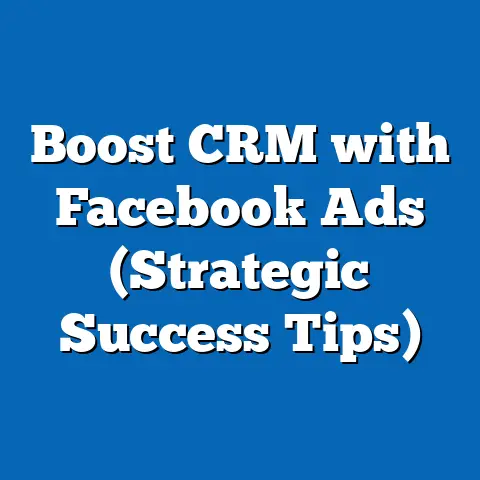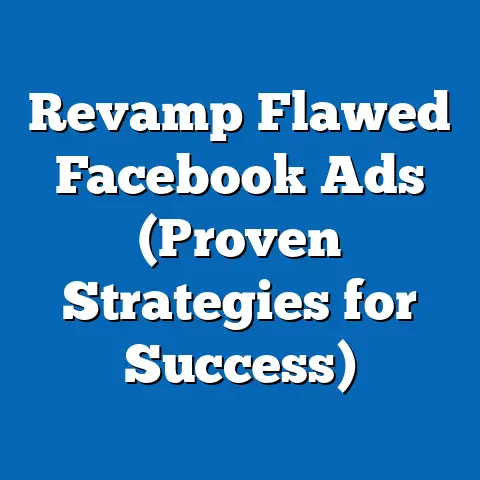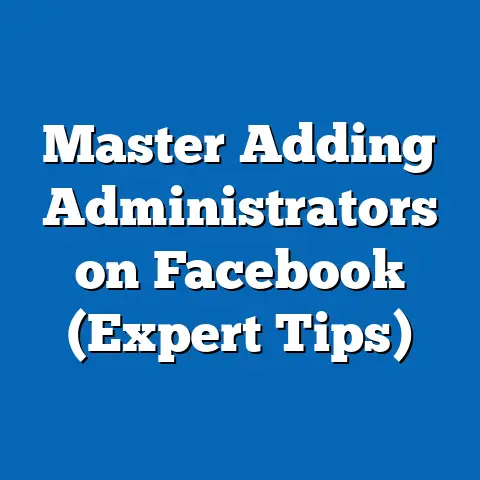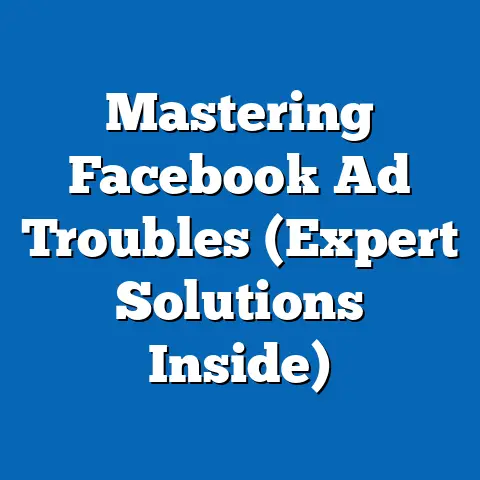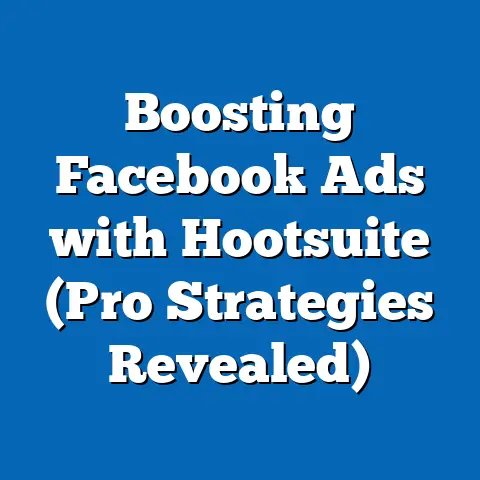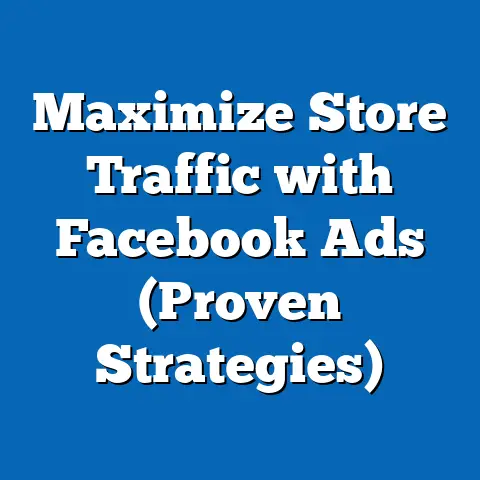Fixing Messenger fb ad Issues (Essential Troubleshooting Guide)
Have you ever felt that sinking feeling when your Facebook Messenger ads just aren’t performing as expected? I remember one particular campaign I launched for a local coffee shop. We were promoting a new summer drink, and I envisioned a flood of customers clicking through the Messenger ad to place orders. Instead, crickets. The ads were running, but the engagement was abysmal. It felt like throwing money into a black hole! That experience taught me the hard way that understanding and troubleshooting Messenger ad issues is absolutely crucial for success. You can have the best product and the most creative ad, but if it’s not reaching the right people or if there’s a technical glitch, it’s all for naught. In this guide, I’ll walk you through common Messenger ad problems and, more importantly, how to fix them, so you can maximize your ad spend and achieve your marketing goals.
Understanding Messenger Ads
Facebook Messenger ads are a powerful tool for connecting directly with your audience. Unlike traditional Facebook ads that lead to a website or landing page, Messenger ads initiate a conversation within the Messenger app. This allows for a more personalized and interactive experience, which can lead to higher engagement and conversion rates.
The benefits of using Messenger ads are numerous:
- Direct Engagement: Initiate one-on-one conversations with potential customers.
- Personalized Experience: Tailor your messaging based on user responses.
- Lead Generation: Collect leads through interactive questionnaires and forms.
- Customer Support: Provide instant support and answer customer queries in real-time.
- Increased Conversions: Guide users through the sales funnel directly within Messenger.
There are several types of Messenger ads available:
- Sponsored Messages: These ads appear directly in a user’s Messenger inbox. They’re ideal for re-engaging existing customers or promoting special offers.
- Click-to-Messenger Ads: These ads appear in the Facebook News Feed or Instagram Feed and, when clicked, open a Messenger conversation. They’re great for driving traffic from social media to your Messenger bot or customer service team.
- Messenger Ads in the News Feed: These ads look like regular News Feed ads but have a Messenger call-to-action button. They’re useful for reaching a broad audience and encouraging them to start a conversation.
According to recent statistics, businesses using Messenger for marketing have seen up to a 20% increase in sales conversions. Messenger ads can be a game-changer for your business if used correctly. But, like any advertising tool, they can also present challenges.
Common Messenger Ad Issues
Even with the best intentions, Messenger ads can sometimes run into problems. Recognizing these common issues is the first step to fixing them. I’ve categorized the most frequent challenges into three main areas: delivery issues, engagement problems, and technical glitches.
Delivery Issues
Definition: Delivery issues occur when your Messenger ads are not being shown to your target audience as frequently as you’d like, or not at all.
Why it’s Important: If your ads aren’t being delivered, you’re essentially wasting your budget. You need impressions to drive engagement and conversions.
Potential Causes:
- Budget Constraints: Your daily or lifetime budget may be too low to reach your desired audience.
- Audience Size: A highly specific or small audience can limit delivery.
- Ad Relevance: Low ad relevance scores can result in lower delivery priority.
- Bidding Strategy: Using an inappropriate bidding strategy can hinder delivery.
- Ad Scheduling: Incorrect ad scheduling can prevent ads from running at optimal times.
Example: I once worked with a client who targeted a very niche demographic with their Messenger ads. They had a small budget and were only running the ads during specific hours. As a result, their ads barely delivered, and they were frustrated with the lack of results.
Engagement Problems
Definition: Engagement problems refer to low click-through rates (CTR), low response rates, and a general lack of interaction with your Messenger ads.
Why it’s Important: Engagement is a key indicator of ad performance. Low engagement suggests that your ads aren’t resonating with your audience.
Potential Causes:
- Poor Creative: Unattractive or irrelevant ad images or videos can discourage clicks.
- Irrelevant Targeting: Reaching the wrong audience can lead to disinterest.
- Ineffective Call-to-Action (CTA): A weak or unclear CTA can prevent users from engaging.
- Unclear Messaging: Confusing or uninteresting ad copy can turn users away.
- Slow Response Times: Delaying responses within Messenger can lead to user frustration.
Example: In my early days of running Messenger ads, I created an ad with a generic image and a vague CTA. The CTR was terrible, and I quickly realized that I needed to create more compelling visuals and a clearer call to action.
Technical Glitches
Definition: Technical glitches include ad disapprovals, tracking issues, Messenger bot integration problems, and other technical errors that prevent your ads from running smoothly.
Why it’s Important: Technical issues can completely derail your ad campaigns and prevent you from accurately measuring performance.
Potential Causes:
- Ad Disapprovals: Violating Facebook’s advertising policies can lead to ad disapprovals.
- Incorrect Tracking Setup: Improperly configured pixels or tracking parameters can result in inaccurate data.
- Messenger Bot Integration Issues: Problems with your bot’s functionality can hinder user interaction.
- Payment Issues: Payment failures or billing problems can prevent ads from running.
- Account Restrictions: Account restrictions or bans can limit your ability to run ads.
Example: I once spent hours creating a complex Messenger bot flow, only to discover that a small technical error in the JSON code was preventing it from working correctly. It was a frustrating experience, but it taught me the importance of thorough testing.
Takeaway: Knowing these common issues is half the battle. Now, let’s dive into how to fix them.
Step-by-Step Troubleshooting Guide
Now that we’ve identified the common issues, let’s get to the heart of the matter: how to fix them. I’ll provide a step-by-step guide for resolving delivery issues, improving engagement, and fixing technical glitches.
Resolving Delivery Issues
-
Check Audience Parameters and Refine Targeting:
- Action: Go to your Facebook Ads Manager and review your target audience settings.
- Explanation: Ensure your audience is not too narrow or too broad. A very narrow audience might limit delivery, while a very broad audience might not be relevant enough.
- Tip: Use Facebook’s Audience Insights tool to get a better understanding of your target audience and identify potential interests or behaviors to add to your targeting criteria.
- Example: If you’re targeting “small business owners” in a specific city, consider expanding to related interests like “entrepreneurship” or “business development.”
-
Adjust Budget and Bid Settings:
-
Action: Review your daily or lifetime budget and bid strategy in Ads Manager.
- Explanation: A low budget might prevent your ads from being shown frequently enough. Experiment with different bidding strategies, such as automatic bidding or manual bidding, to see what works best for your campaign.
- Tip: Start with a higher budget and gradually reduce it as you optimize your campaign. This will allow you to gather more data quickly.
- Example: If you’re using automatic bidding, consider switching to manual bidding and setting a maximum bid to control your costs.
-
Review Ad Relevance and Quality Score:
-
Action: Check your ad relevance diagnostics in Ads Manager.
- Explanation: Facebook assigns a relevance score to your ads based on how relevant they are to your target audience. A low relevance score can negatively impact delivery.
- Tip: Improve your ad relevance by creating more targeted ads that resonate with your audience. Use high-quality images or videos, write compelling ad copy, and ensure your landing page (if applicable) is relevant to your ad.
- Example: If your ad relevance score is low, try creating multiple ad variations with different headlines, images, and body copy to see which performs best.
Check Audience Parameters and Refine Targeting:
- Action: Go to your Facebook Ads Manager and review your target audience settings.
- Explanation: Ensure your audience is not too narrow or too broad. A very narrow audience might limit delivery, while a very broad audience might not be relevant enough.
- Tip: Use Facebook’s Audience Insights tool to get a better understanding of your target audience and identify potential interests or behaviors to add to your targeting criteria.
- Example: If you’re targeting “small business owners” in a specific city, consider expanding to related interests like “entrepreneurship” or “business development.”
-
Adjust Budget and Bid Settings:
-
Action: Review your daily or lifetime budget and bid strategy in Ads Manager.
- Explanation: A low budget might prevent your ads from being shown frequently enough. Experiment with different bidding strategies, such as automatic bidding or manual bidding, to see what works best for your campaign.
- Tip: Start with a higher budget and gradually reduce it as you optimize your campaign. This will allow you to gather more data quickly.
- Example: If you’re using automatic bidding, consider switching to manual bidding and setting a maximum bid to control your costs.
-
Review Ad Relevance and Quality Score:
-
Action: Check your ad relevance diagnostics in Ads Manager.
- Explanation: Facebook assigns a relevance score to your ads based on how relevant they are to your target audience. A low relevance score can negatively impact delivery.
- Tip: Improve your ad relevance by creating more targeted ads that resonate with your audience. Use high-quality images or videos, write compelling ad copy, and ensure your landing page (if applicable) is relevant to your ad.
- Example: If your ad relevance score is low, try creating multiple ad variations with different headlines, images, and body copy to see which performs best.
Adjust Budget and Bid Settings:
Action: Review your daily or lifetime budget and bid strategy in Ads Manager.
Review Ad Relevance and Quality Score:
Action: Check your ad relevance diagnostics in Ads Manager.
Improving Engagement
-
Analyze Ad Creatives and Provide Tips for Improvement:
- Action: Review your ad images and videos to ensure they are visually appealing and relevant to your target audience.
- Explanation: High-quality visuals are crucial for capturing attention and driving engagement.
- Tip: Use bright colors, eye-catching imagery, and short, engaging videos. Consider using user-generated content to build trust and authenticity.
- Example: I’ve found that using images of real people interacting with a product often performs better than generic stock photos.
-
Optimize CTAs and Experiment with Different Messaging Strategies:
-
Action: Test different call-to-action buttons and messaging strategies to see what resonates best with your audience.
- Explanation: A strong CTA can encourage users to take action, such as “Learn More,” “Shop Now,” or “Send Message.”
- Tip: Use clear and concise language that tells users exactly what you want them to do. Experiment with different messaging strategies, such as highlighting benefits, creating a sense of urgency, or offering a special discount.
- Example: Instead of using a generic “Learn More” CTA, try “Get Your Free Guide Now!” to create a sense of urgency and encourage clicks.
-
A/B Testing Recommendations for Better Performance Insights:
-
Action: Conduct A/B tests to compare different ad variations and identify the most effective elements.
- Explanation: A/B testing allows you to test different headlines, images, CTAs, and targeting options to see what performs best.
- Tip: Use Facebook’s built-in A/B testing tool to easily create and track your tests. Focus on testing one element at a time to get clear insights.
- Example: Test two different headlines to see which one generates a higher CTR. Or, test two different images to see which one is more visually appealing.
Analyze Ad Creatives and Provide Tips for Improvement:
- Action: Review your ad images and videos to ensure they are visually appealing and relevant to your target audience.
- Explanation: High-quality visuals are crucial for capturing attention and driving engagement.
- Tip: Use bright colors, eye-catching imagery, and short, engaging videos. Consider using user-generated content to build trust and authenticity.
- Example: I’ve found that using images of real people interacting with a product often performs better than generic stock photos.
-
Optimize CTAs and Experiment with Different Messaging Strategies:
-
Action: Test different call-to-action buttons and messaging strategies to see what resonates best with your audience.
- Explanation: A strong CTA can encourage users to take action, such as “Learn More,” “Shop Now,” or “Send Message.”
- Tip: Use clear and concise language that tells users exactly what you want them to do. Experiment with different messaging strategies, such as highlighting benefits, creating a sense of urgency, or offering a special discount.
- Example: Instead of using a generic “Learn More” CTA, try “Get Your Free Guide Now!” to create a sense of urgency and encourage clicks.
-
A/B Testing Recommendations for Better Performance Insights:
-
Action: Conduct A/B tests to compare different ad variations and identify the most effective elements.
- Explanation: A/B testing allows you to test different headlines, images, CTAs, and targeting options to see what performs best.
- Tip: Use Facebook’s built-in A/B testing tool to easily create and track your tests. Focus on testing one element at a time to get clear insights.
- Example: Test two different headlines to see which one generates a higher CTR. Or, test two different images to see which one is more visually appealing.
Optimize CTAs and Experiment with Different Messaging Strategies:
Action: Test different call-to-action buttons and messaging strategies to see what resonates best with your audience.
A/B Testing Recommendations for Better Performance Insights:
Action: Conduct A/B tests to compare different ad variations and identify the most effective elements.
Fixing Technical Glitches
-
Guide Through the Process of Reviewing Ad Disapprovals and Making Necessary Adjustments:
- Action: Check your Facebook Ads Manager for any ad disapprovals.
- Explanation: If your ad is disapproved, Facebook will provide a reason for the disapproval.
- Tip: Review Facebook’s advertising policies carefully to ensure your ads comply with all guidelines. Make the necessary adjustments and resubmit your ad for review.
- Example: I once had an ad disapproved because it violated Facebook’s policy on misleading claims. I revised the ad copy to remove the misleading claim and resubmitted it for review, and it was approved.
-
Troubleshoot Tracking Issues and Ensure Proper Setup:
-
Action: Verify that your Facebook Pixel is installed correctly on your website and that it’s tracking events accurately.
- Explanation: The Facebook Pixel is essential for tracking conversions and optimizing your ad campaigns.
- Tip: Use the Facebook Pixel Helper Chrome extension to verify that your pixel is installed correctly. Check your event setup to ensure that you’re tracking the right events, such as purchases, leads, or page views.
- Example: I once discovered that my Facebook Pixel was not tracking purchase events correctly. I reconfigured the pixel and verified the setup using the Pixel Helper, and the issue was resolved.
-
Provide Insights on Integrating and Optimizing Messenger Bots for Better User Interaction:
-
Action: Ensure that your Messenger bot is integrated correctly with your Facebook page and that it’s functioning as expected.
- Explanation: A well-designed Messenger bot can enhance user interaction and improve engagement.
- Tip: Test your bot thoroughly to ensure it’s providing accurate and helpful information. Optimize your bot’s flow to guide users through the sales funnel and encourage conversions.
- Example: I’ve found that using a Messenger bot to provide instant customer support can significantly improve customer satisfaction and drive sales.
Guide Through the Process of Reviewing Ad Disapprovals and Making Necessary Adjustments:
- Action: Check your Facebook Ads Manager for any ad disapprovals.
- Explanation: If your ad is disapproved, Facebook will provide a reason for the disapproval.
- Tip: Review Facebook’s advertising policies carefully to ensure your ads comply with all guidelines. Make the necessary adjustments and resubmit your ad for review.
- Example: I once had an ad disapproved because it violated Facebook’s policy on misleading claims. I revised the ad copy to remove the misleading claim and resubmitted it for review, and it was approved.
-
Troubleshoot Tracking Issues and Ensure Proper Setup:
-
Action: Verify that your Facebook Pixel is installed correctly on your website and that it’s tracking events accurately.
- Explanation: The Facebook Pixel is essential for tracking conversions and optimizing your ad campaigns.
- Tip: Use the Facebook Pixel Helper Chrome extension to verify that your pixel is installed correctly. Check your event setup to ensure that you’re tracking the right events, such as purchases, leads, or page views.
- Example: I once discovered that my Facebook Pixel was not tracking purchase events correctly. I reconfigured the pixel and verified the setup using the Pixel Helper, and the issue was resolved.
-
Provide Insights on Integrating and Optimizing Messenger Bots for Better User Interaction:
-
Action: Ensure that your Messenger bot is integrated correctly with your Facebook page and that it’s functioning as expected.
- Explanation: A well-designed Messenger bot can enhance user interaction and improve engagement.
- Tip: Test your bot thoroughly to ensure it’s providing accurate and helpful information. Optimize your bot’s flow to guide users through the sales funnel and encourage conversions.
- Example: I’ve found that using a Messenger bot to provide instant customer support can significantly improve customer satisfaction and drive sales.
Troubleshoot Tracking Issues and Ensure Proper Setup:
Action: Verify that your Facebook Pixel is installed correctly on your website and that it’s tracking events accurately.
Provide Insights on Integrating and Optimizing Messenger Bots for Better User Interaction:
Action: Ensure that your Messenger bot is integrated correctly with your Facebook page and that it’s functioning as expected.
Takeaway: Troubleshooting is an ongoing process. Regularly monitor your ad performance and make adjustments as needed to optimize your campaigns.
Tools and Resources for Monitoring Messenger Ads
Monitoring your Messenger ad performance is crucial for identifying issues and optimizing your campaigns. Here are some helpful tools and resources:
- Facebook Ads Manager: The primary tool for creating, managing, and monitoring your Facebook ads. It provides detailed data on impressions, clicks, CTR, and conversions.
- Facebook Analytics: Provides insights into user behavior and engagement within Messenger.
- Third-Party Analytics Tools: Tools like Google Analytics can provide additional insights into your website traffic and conversions.
- Facebook Business Help Center: A comprehensive resource for finding answers to common questions and troubleshooting issues.
- Messenger Marketing Best Practices: Stay up-to-date with the latest best practices for Messenger marketing to optimize your campaigns.
Takeaway: Use these tools and resources to monitor your ad performance, identify issues, and make data-driven decisions to improve your campaigns.
Conclusion
Effectively troubleshooting Messenger ad issues is essential for maximizing your advertising ROI and achieving your marketing goals. By understanding the common challenges, following the step-by-step troubleshooting guide, and utilizing the available tools and resources, you can overcome obstacles and optimize your campaigns for success. Remember to stay informed about updates and changes in Facebook advertising policies to continuously refine your strategies. Now go forth and conquer the world of Messenger ads! Your success is just a few tweaks away.

